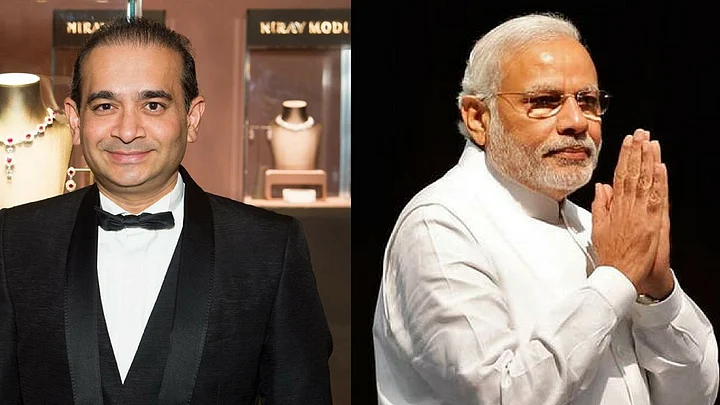Narendra Modi is a master craftsman of managing public perceptions. It’s unusual, therefore, to see his government and its cheerleaders fumbling to counter the Congress narrative around the great escape under Modi’s watch of yet another alleged swindler.
Even as government ministers strain to shift the blame for diamond billionaire Nirav Modi’s Rs 11,300 crore financial fraud to the UPA government which was in power in 2011 when the scam first began, even as investigative agencies scramble to make up for lost time in detection with extensive raids on his properties, even as BJP spokespersons and disgruntled former Congressmen scream themselves hoarse about Rahul Gandhi inaugurating a Nirav bridal show in 2013, somehow mud seems to be flying in the other direction.
The key issue is that while Nirav’s “crimes” may belong to another era, he and his family managed to flee India in Modi’s times.
Extradition processes being lengthy and cumbersome, it looks like Nirav Modi will manage to escape investigation and trial.
The similarities with the stealthy exit of two others accused of swindling money, liquor baron Vijay Mallaya and cricketing czar Lalit Modi, are too glaring to ignore. Ironically, they too are accused of crimes when the UPA was in power but they slipped out of the country after the Modi government assumed office.
For the first time in four years, Modi’s “na khaunga, na khanedunga” boast has come under a cloud as questions abound why his government was sleeping on the job after the PMO was alerted about the Nirav scam in 2016 through a complaint filed by someone named Hari Prasad.
The complainant has an acknowledgement of receipt from the PMO which apparently escalated the matter to the Registrar of Companies and then seems to have forgotten about it.
It is against this background that a photograph of Nirav and Modi in the same frame at the Davos Summit this year has become the pivot of the Congress attack. Union Minister Ravi Shankar Prasad was at pains to deny that a “personal meeting” between the two took place.
Nirav Modi was there as a CII member like several other Indian entrepreneurs were there.Ravi Shankar Prasad
Unfortunately, Modi is a prisoner of his own image. It defies belief that a powerful, hands on prime minister like Modi would not have personally vetted the list of business leaders who would be present at Davos, attend a CII meeting addressed by him, and be part of a group photograph.
It also defies belief that a complaint filed with the PMO of a bank fraud of this scale would not have been shown to Modi for information, especially since this government has a voracious appetite for corruption scandals associated with Congress governments.
No official in Modi’s PMO has the kind of power or personal equation with the PM that say Brajesh Mishra had with Atal Behari Vajpayee or AN Verma had with Narasimha Rao or PN Haksar had with Indira Gandhi. Mishra, Verma and Haksar were almost alter egos of their bosses who trusted them implicitly to make the right decisions on their behalf.
The two top officers in Modi’s PMO, Nirpen Misra and PK Mishra, know that their boss runs a tight ship and has to be kept in the loop on everything, no matter how small.
Little wonder then that the Congress has gleefully pounced on the Nirav scandal to put Modi on the mat, totally ignoring the fact that its own government cannot escape blame for knowingly or unknowingly allowing the bank fraud to happen.
A simple narrative is always the best in the battle to manage public perceptions. While the BJP and its government labour with facts to defend themselves, the Congress has the luxury of an Opposition party. It can bowl bouncers to thrill and entertain.
Collusion and/or incompetence? Unless Modi brings his phenomenal communications skill into play, the Congress could well run away with a narrative that can only damage the PM and his government in the run-up to next year’s general election.
It is clear that the Nirav scam will dominate Parliament when the Budget Session resumes in March. There is some talk of a demand for a joint parliamentary committee (JPC) but the Congress may have to move cautiously on this since its role in the bank fraud since 2011 could come under the scanner too.
Whatever the facts, the Modi government does seem to be on a slippery slope. It managed to douse the Lalit Modi and Vijay Mallya fires largely because of Modi’s personally clean image and his popularity post his stunning victory in 2014.
But the Nirav scandal has come at a time when Modi is under attack for his economic policies, a damp squib of a Budget and rising social tensions. Can NiMo trip up NaMo? Much depends on how events play out over the next few weeks, particularly when Parliament reopens. Expect plenty of fire and brimstone then.
(At The Quint, we question everything. Play an active role in shaping our journalism by becoming a member today.)
